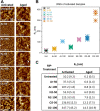Temporal Changes in the Surface Chemistry and Topography of Reactive Ion Plasma-Treated Poly(vinyl alcohol) Alter Endothelialization Potential
- PMID: 38117934
- PMCID: PMC10788828
- DOI: 10.1021/acsami.3c16759
Temporal Changes in the Surface Chemistry and Topography of Reactive Ion Plasma-Treated Poly(vinyl alcohol) Alter Endothelialization Potential
Abstract
Synthetic small-diameter vascular grafts (<6 mm) are used in the treatment of cardiovascular diseases, including coronary artery disease, but fail much more readily than similar grafts made from autologous vascular tissue. A promising approach to improve the patency rates of synthetic vascular grafts is to promote the adhesion of endothelial cells to the luminal surface of the graft. In this study, we characterized the surface chemical and topographic changes imparted on poly(vinyl alcohol) (PVA), an emerging hydrogel vascular graft material, after exposure to various reactive ion plasma (RIP) surface treatments, how these changes dissipate after storage in a sealed environment at standard temperature and pressure, and the effect of these changes on the adhesion of endothelial colony-forming cells (ECFCs). We showed that RIP treatments including O2, N2, or Ar at two radiofrequency powers, 50 and 100 W, improved ECFC adhesion compared to untreated PVA and to different degrees for each RIP treatment, but that the topographic and chemical changes responsible for the increased cell affinity dissipate in samples treated and allowed to age for 230 days. We characterized the effect of aging on RIP-treated PVA using an assay to quantify ECFCs on RIP-treated PVA 48 h after seeding, atomic force microscopy to probe surface topography, scanning electron microscopy to visualize surface modifications, and X-ray photoelectron spectroscopy to investigate surface chemistry. Our results show that after treatment at higher RF powers, the surface exhibits increased roughness and greater levels of charged nitrogen species across all precursor gases and that these surface modifications are beneficial for the attachment of ECFCs. This study is important for our understanding of the stability of surface modifications used to promote the adhesion of vascular cells such as ECFCs.
Keywords: cardiovascular biomaterials; endothelialization; hydrophobic recovery; nanotopography; poly(vinyl alcohol); reactive ion plasma.
Conflict of interest statement
The authors declare no competing financial interest.
Figures






References
-
- Zeng W.; Li Y.; Wang Y.; Cao Y.. Tissue Engineering of Blood Vessels. In Encyclopedia of Tissue Engineering and Regenerative Medicine; Reis R. L., Ed.; Academic Press: Oxford, 2019; pp 413–424 10.1016/B978-0-12-801238-3.65848-8. - DOI
-
- Lüscher T. F. Vascular Biology of Coronary Bypass Grafts. Curr. Opin. Cardiol. 1991, 6 (6), 868–876. - PubMed
-
- Park K.-S.; Kang S. N.; Kim D. H.; Kim H.-B.; Im K. S.; Park W.; Hong Y. J.; Han D. K.; Joung Y. K. Late Endothelial Progenitor Cell-Capture Stents with CD146 Antibody and Nanostructure Reduce in-Stent Restenosis and Thrombosis. Acta Biomater. 2020, 111, 91–101. 10.1016/j.actbio.2020.05.011. - DOI - PubMed
MeSH terms
Substances
Grants and funding
LinkOut - more resources
Full Text Sources
Research Materials
Miscellaneous

